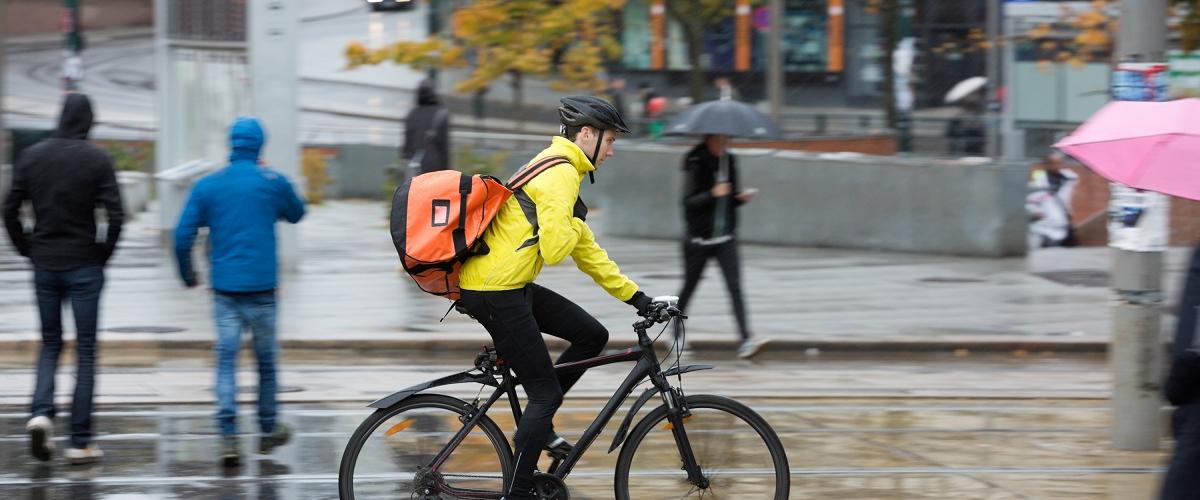Walking, biking and riding an electric scooter (e-scooter) are healthy, environmentally friendly transportation options. More people are walking, biking or scooting to work, cities are implementing micromobility programs (shared bikes and e-scooters) and transportation planners are increasingly taking pedestrians,bicyclists and scooter riders into account when making infrastructure improvements.
GHSA PolicyClick here to view GHSA's policy and priorities on Bicyclist and Pedestrian Safety. |
Unfortunately, pedestrians, cyclists and scooter riders are at an inherent disadvantage when involved in traffic crashes: When a faster-moving vehicle collides with them, the vehicle always wins. Advances in crashworthiness and technology have contributed to the decline in vehicle occupant deaths, but people outside of vehicles remain susceptible to serious injury or death when struck by a motor vehicle.
GHSA projects that drivers struck and killed 7,318 people walking in 2023 – down 5% from the year before but 14% above 2019, the last pre-pandemic year (Pedestrian Traffic Fatalities by State: 2023 Preliminary Data [January-December], GHSA). This comes on the heels of a four-decade high of more than 7,500 pedestrian deaths in 2022.

Multiple studies show that people of color are disproportionately represented in pedestrian fatalities. One research paper found non-Hispanic Black persons have a pedestrian death rate 118% higher than non-Hispanic white individuals (Disparities in Activity and Traffic Fatalities by Race/Ethnicity, American Journal of Preventative Medicine). More alarmingly, when looking at rates for pedestrian deaths occurring at night, the rate for non-Hispanic Black persons was 236% higher than non-Hispanic white persons. Hispanic or Latino pedestrians are also much more vulnerable at night, experiencing a fatality rate 84% higher than non-Hispanic white individuals.
A Centers for Disease Control and Prevention study provides further evidence of racial disparity among people on foot: The proportion of visits to U.S. emergency rooms for pedestrian injuries was 1.53 to 2.47 times higher for six racial and ethnic minority groups than among non-Hispanic white people (Emergency Department Visits for Pedestrians Injured in Motor Vehicle Traffic Crashes — United States, January 2021–December 2023).
Each year approximately 2% of fatalities resulting from motor vehicle crashes are people on bicycles. In 2023, 1,149 bicyclists were killed on U.S. roadways, up 4% from 2022 (Early Estimates of Motor Vehicle Traffic Fatalities and Fatality Rate by Sub-Categories in 2023, National Highway Traffic Safety Administration). Although bicyclist deaths have decreased 4% since 1975, they have increased 55% since reaching their lowest point in 2010. Deaths among bicyclists younger than 20 have declined 88% since 1975, while deaths among bicyclists 20 and older have quadrupled. In every year since 1975, many more male than female bicyclists were killed in crashes with motor vehicles (Insurance Institute for Highway Safety).
Electric scooters (e-scooters) exploded in popularity after appearing on city streets virtually overnight in 2018. They are part of a rapidly evolving form of transportation referred to as micromobility, which also includes docked and dockless shared bicycles, skateboards and other personal transportation devices. Micromobility options are popular in crowded urban environments and college campuses but are becoming increasingly commonplace in small towns and on suburban neighborhood streets. Emergency rooms have seen an increase in crashes and head injuries involving e-scooter riders, and many drivers are not accustomed to sharing the road with this new form of transportation. GHSA’s report, Understanding and Tackling Micromobility: Transportation's New Disruptor, funded by State Farm®, offers concrete examples of what State Highway Safety Offices (SHSOs) can do in partnership with others to ensure micromobility riders and all road users safely share the road.
GHSA recognizes the importance of bicyclist, pedestrian and micromobility rider safety, and its member SHSOs administer programs focused on improving safety for people who using these modes. A few examples:
- Street Smart NJ, a collaborative program that is supported by the New Jersey Division of Highway Traffic Safety, educates drivers about safely sharing the road through equitable enforcement of the state’s law mandating that drivers stop for pedestrians in the crosswalk, grassroots public education and outreach, and pop-up and low-cost infrastructure improvements. Research confirms the campaign is sparking positive changes in both reported and observed behaviors by drivers and people on foot, and greater awareness of pedestrian safety laws.
- The Go Human Bicycle/Pedestrian Safety Program, led by the Southern California Association of Governments, with support from the California Office of Traffic Safety, works collaboratively to reduce collisions involving people walking and biking through public outreach, community engagement and safety demonstration projects. The latter includes a lending library of safety materials, called Kit of Parts, which allows jurisdictions to borrow and utilize equipment to test street infrastructure improvements with the public. To date, more than one third of these safety projects have been funded or permanently installed.
- Scoot Safe, a collaboration between the Georgia Governor’s Office of Highway Safety and Shepherd Center is the first federally funded, evidence-based e-scooter injury prevention campaign in the nation. The partnership between highway safety and brain trauma experts led to the creation of a safe scooting checklist that cities and municipalities can customize and share with riders and a series of short videos highlighting the importance of following e-scooter provider safety instructions, why you should always wear a helmet and the dangers of using an e-scooter while under the influence of alcohol and other impairing substances.
Featured Initiative
Youth Active Transportation Safety Grant Results: Colorado
The Colorado Office of Transportation Safety partnered with Adelante Community Development, a non-profit organization focused on serving Latino families and entrepreneurs, to recruit and train teens as part of the Traffic Safety Youth Advisory Board. These teens were trained to be ambassadors and educated their peers in Commerce City about pedestrian, bicycle and other safe mobility practices.
Read More



